Introduction
While the Chinese apparel industry was elementary in terms of size, product variety, and production technologies during the Maoist era, by 1994, China had become the world’s largest clothing producer.Footnote 1 It has experienced an impressive development, from an output value of CNY 13.5 billion in 1980 to CNY 229 billion in 2000, and CNY 2.366 trillion in 2016. This growth relied mostly on foreign markets. The share of production exported grew dramatically from 17 percent in 1981 to 66 percent in 1990 and more than 90 percent in 1992–2006, making China the world’s largest apparel exporter (see Figure 1). Scholars in economics, management, and business history have explained this impressive development as the consequence of inward foreign direct investment (FDI) by foreign companies looking for cheap laborFootnote 2 and institutional change that allowed the formation of private companies.Footnote 3
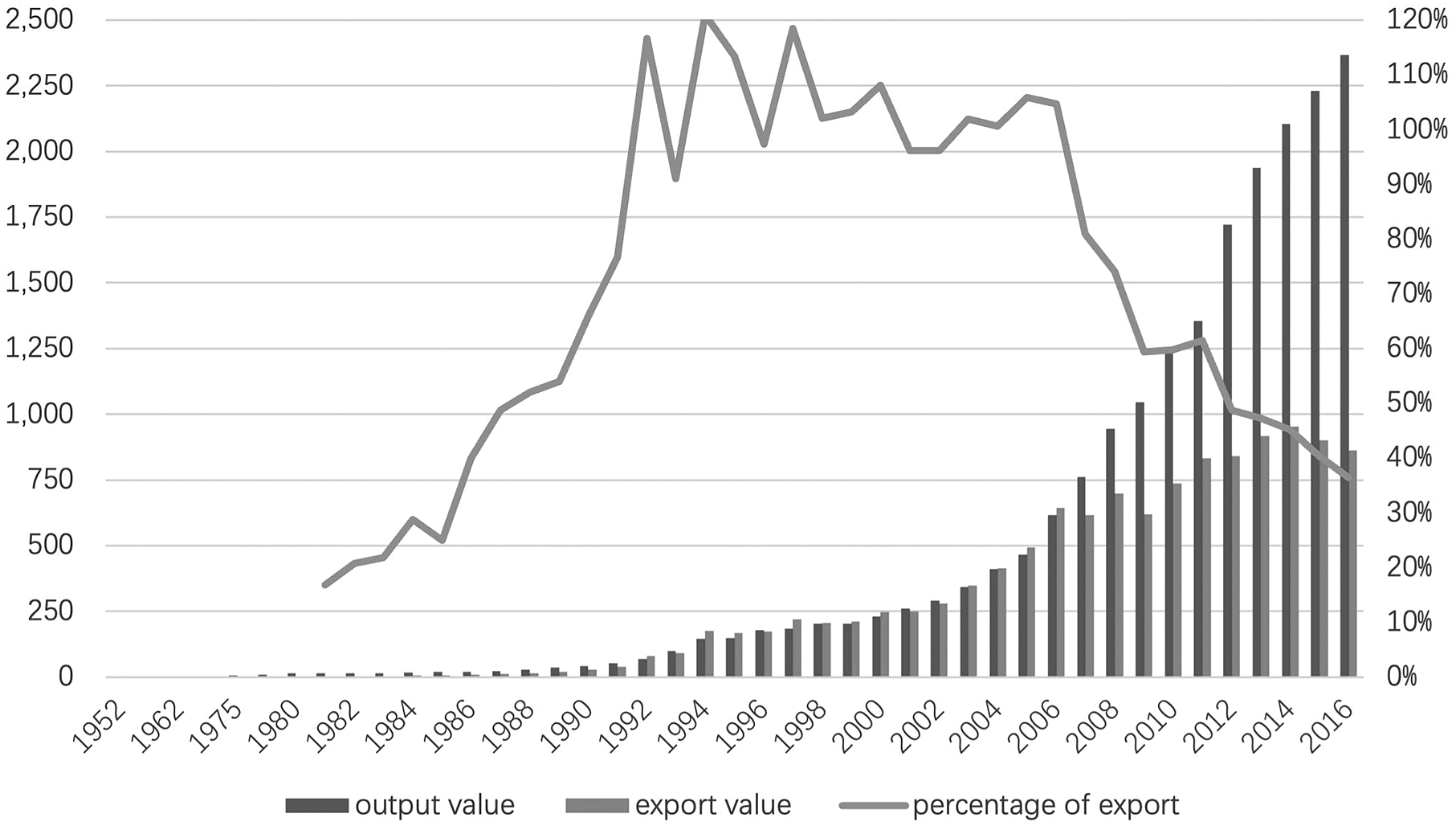
Figure 1. Output and export of Chinese apparel industry (CNY billion).
Total industrial output value was no longer censused after 2011. Thus, the data after 2011 are replaced by industrial sales output value, which is slightly lower than total industrial output value. There are no data of apparel output value after 2016. The output value is calculated in Chinese yuan (CNY) by the Industrial and Transportation Statistics Department of the National Bureau of Statistics, while the export value is calculated in U.S. dollars (USD) by the General Administration of Customs. The authors adjusted the export value into CNY units using the average exchange rate for the year provided by the State Administration of Foreign Exchange. The combination of these two factors has resulted in the export value of some years being higher than the output value in results.
Sources: China Industry Statistical Yearbook, 1985–2020; China Statistical Yearbook, 1982–2020.
However, production and export statistics also emphasize a major shift after 2005: While production continued its fast expansion, the export share started to decline. It amounted to only 60 percent of production in 2010 and decreased to less than 40 percent in 2016, returning to 1980s’ levels. Although China continued to be a major apparel exporter with a world’s share of 30.7 percent in 2019, the new growth of its apparel industry was in the domestic market.Footnote 4 This shift occurred in a highly competitive environment as foreign companies entered the Chinese market en masse—first with luxury fashion brands in the late 1990s and then with fast fashion brands after 2000.Footnote 5 Despite these conditions, Chinese companies have built a strong competitive advantage against foreign brands in the domestic market, with half of the top ten apparel brands in the Chinese market in 2019.Footnote 6 This is an impressive proportion in comparison with other countries. According to the consulting firm GlobalData, in 2023, the top ten largest apparel companies included only four domestic firms in Germany, three in Australia, and three in South Korea. China had a share of domestic companies similar to nations with a large and competitive apparel industry, such as France, Italy, and Japan (all with five domestic firms).Footnote 7
This successful development has attracted the attention of scholars in sociology and cultural studies, who have documented the slow emergence of a fashion system in China since 2000,Footnote 8 with a special focus on the actions developed by a new generation of Chinese designers trained abroad.Footnote 9 Simona Segre Reinach analyzed the relationships between Chinese apparel makers and foreign brands through joint ventures (JVs), stressing a gradual decline of cooperation due to frictions between foreign entrepreneurs’ fast-track mentality and Chinese enterprises’ bureaucratic operational systems.Footnote 10 Business historian Rui Shi’s article on the transformation of Chinese department stores since the 1980s suggested the new Chinese apparel brands needed new retail channels to build their expansion after 2005.Footnote 11 Meanwhile, Chinese economists have demonstrated that Chinese apparel companies began to undergo industrial upgrading after the 2000s under pressure from rising costs and labor shortages. They typically elect to move up to become branded retailers, transition to an intermediate position that undertakes original design manufacturing (ODM), or engage in vertical integrations of the production value chain.Footnote 12 Despite the emergence of some designer brands in recent years, many scholars believe the most important barriers to the transformation of Chinese apparel companies are still the shortage of competitive brands, design and marketing expertise, and technology innovation capabilities.Footnote 13 Institutional support and the rapid development of e-commerce, in particular, have helped the industry upgrade and integrate into the global value chain.Footnote 14 In this process, domestic apparel companies have witnessed the trend of regionalization and delocalization, relocating their production to inland cities or Southeast Asia.Footnote 15
How Chinese apparel companies were able to build competitive advantages to dominate their domestic market is still unclear. Literature in economics about the growth of apparel production has demonstrated that electronic-based technical innovations led to the automatization of production and computerization of design and management processes, which drastically increased productivity in the 1980s and 1990s, especially in Asia.Footnote 16 Technology transfer was a critical factor for Chinese apparel companies to raise productivity and enhance exports. However, fashion, which is rooted in design, global value chain (GVC) management, and marketing expertise, has been explained by scholars as the core competitiveness creating entry barriers for apparel companies.Footnote 17 Thus, the companies required knowledge upgrades in the domestic-oriented period. However, the way these firms have accessed and used different knowledge remains largely unexplored.
A second major issue is understanding the relationships between the apparel companies that dominated the domestic market after 2005 and the Chinese apparel manufacturers that dominated world exports in the 1980s and 1990s. Are they similar firms that shifted their market from global to local? If not, where did these new firms come from and how did they acquire the knowledge necessary for their growth?
Hence, the Chinese apparel industry experienced the emergence of original equipment manufacturers (OEMs) in the 1980s, followed by domestic retailers after 2005. Both kinds of companies differ regarding their markets and the knowledge needed to build competitive advantages. To analyze their expansion, we use the GVC model developed by Gary Gereffi. This model highlights the different ways companies can upgrade their position in the chain and grow through value acquisition. This model is discussed in the next section.
The GVC in the Apparel Industry
The organizational model of the GVC developed by Gary Gereffi represents an appropriate analytical tool to discuss the issue of knowledge upgrades in the Chinese apparel industry.Footnote 18 Since its formation in the 1980s, this industry has not been composed of fully vertically integrated firms, which would internally control all activities related to the apparel business, from design and marketing to production, distribution, and retail. Rather, firms have focused on specific parts of the chain, mostly production, and depended on other companies, mostly foreign, for other activities.
Gereffi has argued that the governance of the chain, and consequently the opportunities and the conditions to improve one’s position within it, took various forms. In some industries, like the automobile industry, companies with the ability to design and manufacture a technically complex product dominate the GVC (producer-driven GVC). In other industries, like branded consumer goods, marketing and retail are the key determinants of competitiveness (buyer-driven GVC). The apparel industry belongs to the latter group. Taking the example of the U.S. apparel industry, Gereffi demonstrated that department stores and fashion retailers controlled this business because they had been able to develop brands and build networks of stores throughout the country since the 1960s. The added value of apparel came from these marketing activities, while production was outsourced to hundreds of independent manufacturing companies through various intermediaries, including trading companies, overseas buyers, and factories.Footnote 19 The formation of GVC in the apparel industry was accompanied by a geographic expansion. Production has become more and more focused in mainland China and other Asian countries, while retailers are centered in the United States, western Europe, and Japan, with Hong Kong playing a new role as an intermediary.Footnote 20 For example, although apparel production has declined drastically in Germany since the 1950s, German companies are still competitive in the apparel industry, particularly in sportswear, due to their ability to control marketing and retail.Footnote 21 The U.S. luxury fashion company Ralph Lauren Corporation, founded in 1967, had no production facilities at the time of its initial public offering in 1997 but outsourced production to about 180 manufacturers around the world, especially in Asia.Footnote 22
However, the companies that occupy a lower position in the GVC can change their position in the chain and add more value. Research in the electronics and automotive industries in East Asia has shown that technological development was how some subcontractors were able to innovate, offer new components to their partners, and consequently increase their share of the value-added of the end product.Footnote 23 Moreover, modularization of product architecture and digitalization allowed new companies in emerging countries to access these modules and assemble them in an end product without becoming the supplier of a multinational enterprise. For example, this is the case in the Chinese mobile phone industry.Footnote 24 Indirect technology transfer from Apple’s suppliers enabled domestic firms like Huawei and Xiaomi to experience fast growth.Footnote 25
Gereffi argued that the associations with leading international firms were major knowledge and technology transfer sources for local companies undertaking OEM production in the buyer-driven apparel commodity chain.Footnote 26 Scholars in economics have econometrically demonstrated the positive effect of foreign trade and FDI on technological spillovers in the Chinese apparel industry from the 1980s to the early 2000s.Footnote 27 Import of advanced technology, OEM linkages with Western companies, mergers and acquisitions (M&As), and employment of foreign experts have been referred to briefly in some studies on the Chinese fashion system and its approach to industrial upgrading through knowledge acquisition.Footnote 28 For example, the back-and-forth discussions on the samples based on the designs provided by Western buyers enabled the transfer of design knowledge to Chinese manufacturers. Yet some scholars noted that this knowledge transfer effect was not always evident, as exemplified in Nike’s outsourcing networks in mainland China, Hong Kong, and Taiwan. Basically, none of these large suppliers has been able to move up to become a branded manufacturer.Footnote 29 However, the extant literature is mainly concentrated on the outcomes of industrial upgrading of the Chinese apparel firms rather than how the specific technologies and knowledge are acquired. Additionally, most of the papers are case studies, which limits their generalizability.
Consequently, although China’s apparel companies became the world’s largest exporters in the 1980s and were established as dominant players in their domestic market after 2005, it is necessary to examine the role of knowledge upgrading, that is, the acquisition of technology and knowledge to achieve a higher position in the GVC in order to capture more value, in this two-phase process. Figures 2 and 3 present simplified overviews of the GVC in the apparel industry and the place of Chinese companies within it during these two periods. First, between 1980 and 2005, Chinese apparel firms were the suppliers of clothing to worldwide retailers through intermediaries, usually based in Hong Kong. However, this industrial growth was not a natural consequence of low wages and institutional change in China. Competition between Chinese apparel firms was tough; some used foreign knowledge to establish themselves as the leading firms in this industry. One must consecutively discuss the nature (machinery, equipment, patents, technical guidance, etc.) and sources (global retailers, overseas buyers, etc.) of this knowledge transfer (see Figure 2). This can explain the successful rise of export-oriented Chinese apparel producers.
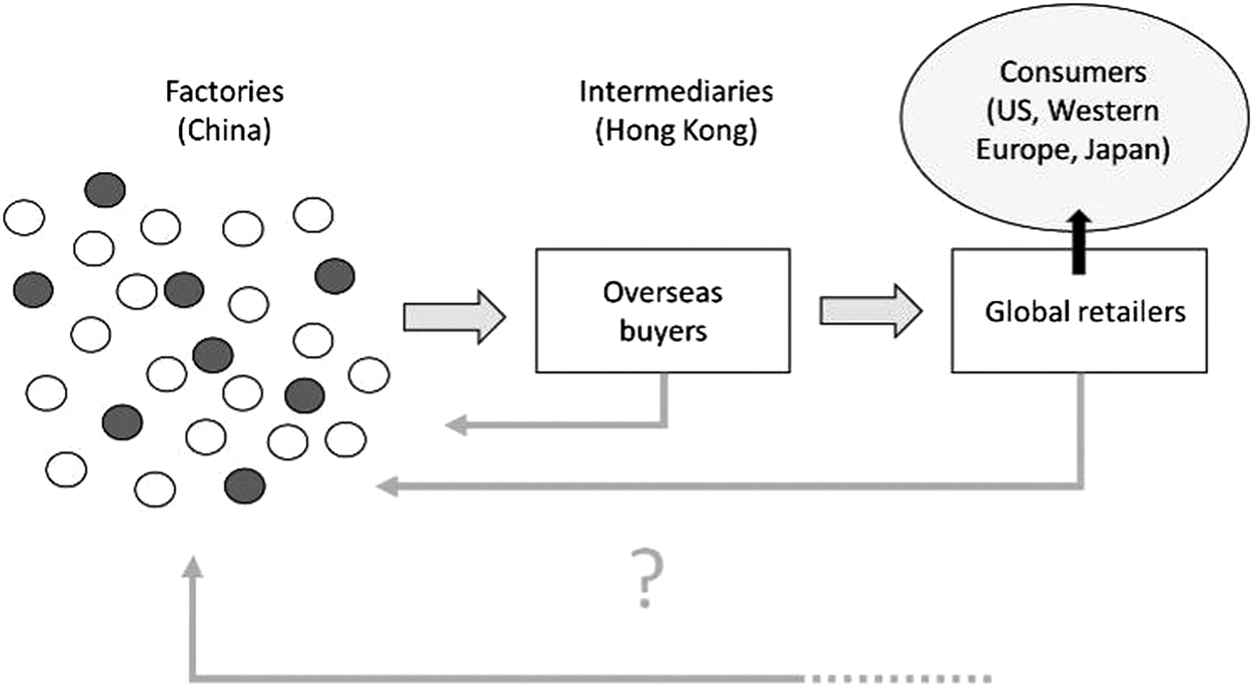
Figure 2 Knowledge upgrade in the Chinese apparel industry, phase I (1980–2005). Gray lines represent knowledge flow.
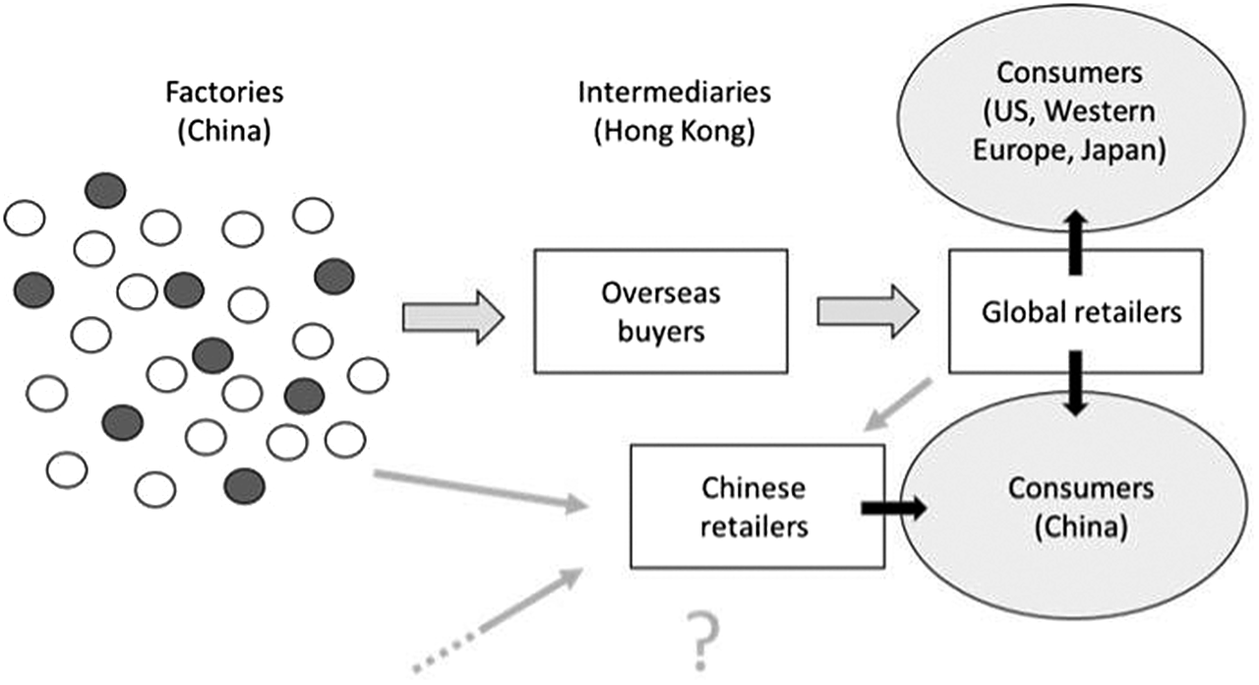
Figure 3. Knowledge upgrade in the Chinese apparel industry, phase II (2005–2020). Gray lines represent knowledge flow.
Second, for the period following 2005, a different kind of knowledge became necessary for Chinese apparel retailers to establish them as dominant players in their domestic market in the context of a competitive environment, as global retailers were also engaged in this market. A new kind of knowledge was necessary to design clothing, build brands, and create a retail network. It enabled some companies to upgrade their position in the value chain. The source of this knowledge transfer must be explored, particularly the relation with Chinese apparel manufacturers (see Figure 3). Were retailers former producers who improved their position in the chain or new companies that used manufacturers as suppliers?
To answer these questions, we used multiple published Chinese sources from the 1980s to the present to gather information on the evolution of the largest apparel firms. Unfortunately, archival materials on the Chinese apparel industry are unavailable, and companies rejected our requests for interviews. However, the broad range and wide variety of our sources made it possible to engage in an analysis based on a “triangulation of source materials” to avoid misunderstanding and correct biases and a “hermeneutic interpretation” to understand the sources in the context they were produced.Footnote 30 The corpus of our printed sources includes a total of two hundred articles that were published in 103 Chinese business magazines and newspapers. We obtained them by searching keywords from the largest academic database in China, CNKI (Chinese National Knowledge Internet). We also obtained articles from China Textile published before 1994 by consulting the hard-copy collections of the National Library of China. Details regarding these sources are presented in the bibliography at the end of this paper. These sources were complemented with official data. We draw on statistics and reports from eleven different yearbooks, mainly national yearbooks such as the Almanac of China’s Textile Industry and China Textile Industry Development Report, supplemented by a small number of provincial and municipal yearbooks, such as the Chengdu Yearbook and Jilin Yearbook. Hence, the extent of sources gathered from newspapers and official publications makes it possible to overcome the “silence of the archives” and carry out relevant business history research on knowledge upgrades in the Chinese apparel industry.Footnote 31
The rest of this paper is organized as follows. First, we offer a general analysis of the long-term transformation of the Chinese apparel industry and the formation of a domestic market in the next two sections. This provides the reader with an overview of the evolution of this business. We then focus on the issue of knowledge upgrading, with both a macroeconomic perspective and case studies of relevant firms. Finally, we discuss our results in the conclusion.
The Transformation of the Chinese Apparel Industry
Before 1949, clothing in China was mostly handcrafted at home or by individual tailors. The latter generally manufactured clothes according to customers’ orders and only occasionally offered ready-made items.Footnote 32 After the foundation of the People’s Republic of China, the new communist government focused on agricultural growth and the restoration of industrial output. In 1953, the government started a socialist transformation (san da gai zao) and implemented a highly centralized planned economy that lasted between 1956 and 1978. In this period, public sectors—including state-owned (SOEs) and collective enterprises (owned by local governments)—made up the entirety of business ownership. Private and foreign-invested enterprises were nonexistent in the economy until 1978.Footnote 33 Apparel production was regulated from both the demand and supply sides. Due to the scarcity of resources, the government implemented a cloth coupon policy in 1953. As a result, each person had only a fixed number of coupons per year to purchase apparel products from state-owned stores. Meanwhile, the authorities controlled and rationed the production of apparel. The situation was even worse during the Cultural Revolution (1966–1976), when the diversification of apparel reached its lowest point, and people were forced to wear uniforms. Briefly, apparel production did not need to meet market demand in a planned economy; instead, it had to conform to state directives. As a result, apparel production remained low throughout the period, increasing barely ninefold over twenty-six years, from CNY 1.02 billion in 1952 to CNY 9.1 billion in 1978 (see Figure 1).
The turning point came in 1978, when the reform and opening up policy led to a gradual shift from a planned economy to a market economy. In 1984, the Ministry of Textile Industry formulated a strategy to prioritize the development of the apparel industry.Footnote 34 The abolishment of the cloth coupon policy in the same year marked the transition of apparel production to market demand. In 1986, the central government established export as the initial strategic goal of the apparel industry’s development in the twentieth century.Footnote 35 Thereafter, the Chinese apparel industry experienced impressive development, reaching an output value of CNY 615.9 billion by 2006, sixty-eight times that of 1978. This dramatic expansion was driven by fast export growth, which represented 16 percent of domestic output in 1981 and remained at an average of greater than 95 percent since the 1990s (see Figure 1).
A major characteristic accompanying the industry’s rapid expansion was the diversification of apparel companies. In the early 1980s, large numbers of rural laborers were freed and shifted to nonagricultural sectors, especially township-village enterprises (TVEs) with higher marginal returns and an unlimited supply of labor, due to agricultural production system reforms.Footnote 36 In 1987, TVEs accounted for more than 88 percent of total apparel enterprises and employed more than 76 percent of the industry’s workforce.Footnote 37 Meanwhile, after the legitimization of FDI in 1979, the central government began to further liberalize FDI and encourage foreign-invested enterprises (in the form of Sino-foreign JVs) in the late 1980s.Footnote 38 By the end of the twentieth century, foreign-invested companies and TVEs accounted for 43 percent and 26 percent of all apparel enterprises, respectively, and thus became the driving force in the apparel industry in the 1990s.Footnote 39
The second inflection point started in the mid-2000s. While export was the driving force of the fast expansion of the Chinese apparel industry in the 1980s and 1990s, the domestic market played a growing role after 2000. The share of export of the national apparel production started to decline after 2005 and has dropped below 50 percent since 2012 (see Figure 1). Simultaneously, TVEs and foreign-invested enterprises gradually lost their dominance in the industry with a series of regulation-related changes. These included the advent of the market economy and the complete liberalization of enterprise privatization in 1992, the new revision of the Foreign Trade Law in 2004, and the official abolishment of the Multi-fiber Arrangement in 2005.Footnote 40 The explosion of private enterprises has made them the absolute dominant player since 2006, accounting for more than 68 percent of all apparel enterprises in 2019.Footnote 41
In short, the Chinese apparel industry experienced tremendous growth by being export oriented from the early 1980s to the mid-2000s, whereas it became increasingly domestic oriented after 2005. The dominant firms and their main markets largely varied in the two periods: township and foreign-invested companies in the 1980s with foreign buyers as the target market, and private firms in the 1990s with domestic consumers as the target market. Accordingly, the knowledge required in these two periods should be different. Hence the knowledge upgrading accompanying this industrial transformation is the issue to be explored in the rest of the paper.
The Growth of the Domestic Apparel Market
The fairly low demand for apparel in the domestic market was a key contributor to the Chinese apparel industry’s export orientation between the early 1980s and the mid-2000s, in addition to the central government’s supportive regulations. Zhao stated that despite the termination of the cloth coupon policy in 1984, the pace of domestic demand growth lagged behind that of productivity growth.Footnote 42 However, after 2000, the domestic market volume expanded quickly in the context of increasing purchasing power and the development of a middle class. In 2017, apparel sales in the domestic market reached CNY 1.455 trillion, more than thirteen times the CNY 106 billion in 2001. Moreover, the annual growth rate of apparel sales remained mostly above 20 percent over the course of the ten years after 2003 (see Figure 4). The vast market potential has gradually prompted apparel companies to become increasingly domestic oriented.
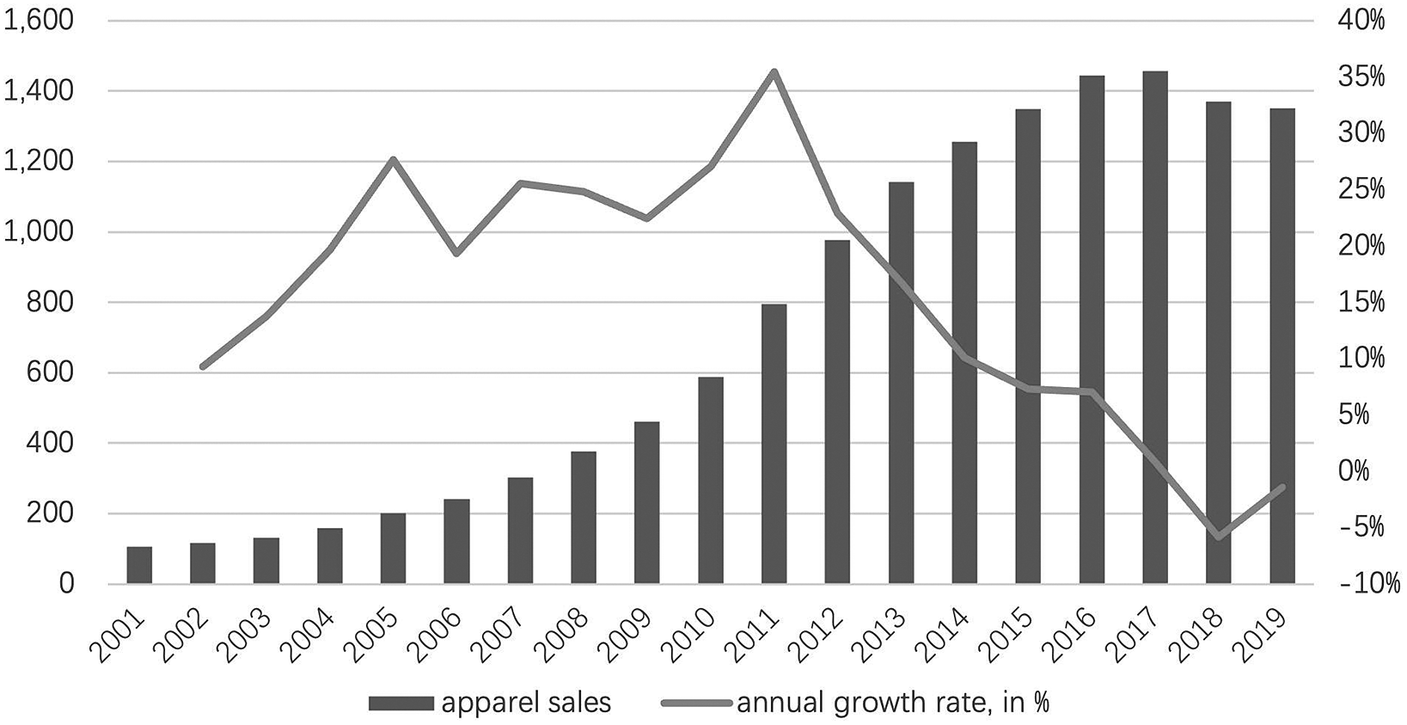
Figure 4. Apparel sales in Chinese market (CNY billion), 2001–2019.
Source: National Bureau of Statistics.
The growth of domestic demand largely facilitated the entry of foreign brands into China. Luxury fashion companies like Ermenegildo Zegna (1991) and Louis Vuitton (1992) were the first to invest in China.Footnote 43 China is now the largest market in terms of sales for many of these companies, including Prada, Gucci, and Zegna, to mention a few.Footnote 44 They were followed in the 2000s by fast fashion brands, including Mango (2002), Uniqlo (2002), Zara (2006), and H&M (2007). In 2019, half of the top ten apparel brands in the Chinese market were foreign, including Nike, Adidas, Uniqlo, Skechers, and Fila.Footnote 45 In the meantime, most of the products from these foreign brands that dominated the Chinese market were manufactured in China.Footnote 46 For instance, more than 90 percent of Uniqlo’s products were produced in China in the early 2000s; today, that figure has dropped to 70 percent due to the company’s strategic transfers to countries with lower labor costs, such as Vietnam and Cambodia after 2008.Footnote 47
Meanwhile, the domestic companies that dominated the market have undergone tremendous transformation over time (see Table 1). As firms with diversified ownership were still in their infancy in the 1980s, all of the key players were SOEs. In the 1990s, the market was dominated by TVEs that were in the process of privatization. Private companies then assumed control after the 2000s. As illustrated in Table 1, the majority of these private companies were not newcomers but came from the privatization of the former leading TVEs or SOEs, such as Youngor, Hongdou, and Heilan, to name a few. Some of the companies established as privately owned enterprises in the 1990s, like Peacebird and Semir, demonstrated vigorous growth in the domestic market as well.
Table 1 The ten largest apparel companies in term of total sales in 1988, 1996, 2006, and 2016
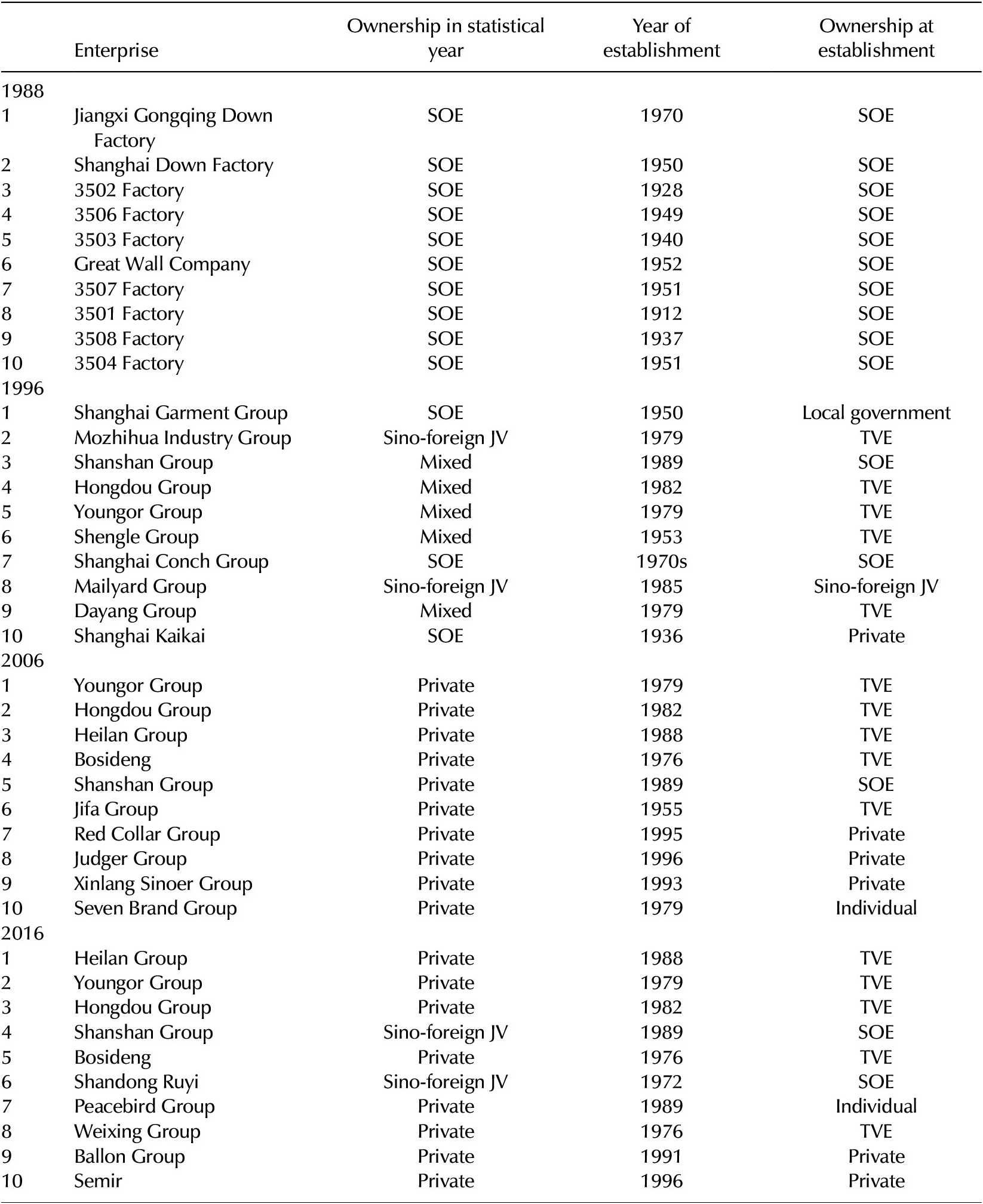
Sources: Management World, 1989(06); Beijing Textile, 1997 (03): 57–59; China National Garment Association published statistics, accessed October 14, 2021, http://www.cnga.org.cn/html/zx/hyxx/2007/0426/1685.html (2006); http://www.cnga.org.cn/html/xiehuigonggao/2017/0718/44756.html (2016). Ownership was established by the authors on the basis of yearbooks, newspapers, and magazines listed in the bibliography.
Note: Data before 1988 are not available. Total sales include export and domestic market sales. JV, joint venture; SOE, state-owned enterprise; TVE, township-village enterprise.
These data show that the shift in orientation from export to domestic did not come from a whole new group of private companies but mostly from the former leading companies’ changing strategies. Thus, the next section will examine how these firms transitioned from the export to the domestic market and how they were able to acquire the knowledge needed in each period.
Knowledge Acquisition and Upgrade of Domestic Apparel Companies
The core knowledge required at the two developmental stages of the Chinese apparel industry took on different forms. Although the apparel industry is generally considered relatively labor-intensive, Chinese apparel production lagged far behind the leading exporters in terms of electronic-based technologies in the early 1980s after three decades of rationed production. Therefore, in addition to labor costs, technology was of great importance for Chinese OEMs to raise productivity, satisfy the requirements of foreign buyers, and enhance exports from the early 1980s to the mid-2000s.
However, soft knowledge is weighed more heavily to upgrade the GVC in the apparel industry. When Chinese apparel firms adopted the strategy of refocusing on the growing domestic market and competing with highly branded foreign firms, acquiring expertise in design, marketing, and branding was critical.
As previously mentioned, the leading companies in the domestic market after 2005 basically established supremacy during the export-oriented period and maintained their dominance through changing strategies. Therefore, it is necessary to explore this transition, from how they acquired knowledge as export-oriented firms to how they upgraded their knowledge when shifting to the domestic market, and to understand further how they were able to change their position in the GVC during the transition.
Technology Transfer in the Export-oriented Apparel Industry
In the early 1980s, the government encouraged bringing in foreign technology and equipment to speed up the technological upgrade of domestic apparel enterprises.Footnote 48 Later, in 1986, it implemented policies to stimulate and assist inward FDI, particularly in export-oriented (products were mainly used for export) and technology-importing (foreign investors provided advanced technologies) enterprises. During this period, most Sino-foreign JVs were rebuilt and transformed from former domestic firms. Typically, the Chinese side made relatively low-cost investments in factories, land, and original equipment, while foreign partners invested in technology, equipment, and high-quality raw materials.Footnote 49
As shown in Table 2, in the 1980s, some of the major SOEs began to import equipment from industrialized countries such as Germany, Japan, and the United States, but very few established Sino-foreign JVs. The reason was twofold. First, foreign-invested enterprises were still in their infancy in China in 1988, accounting for less than 2 percent of total apparel companies.Footnote 50 Second, SOEs had enough financial resources to purchase foreign equipment without the assistance of foreign investment.
Table 2 Technology transfer data for the ten largest apparel companies in 1988, 1996, 2006, 2016
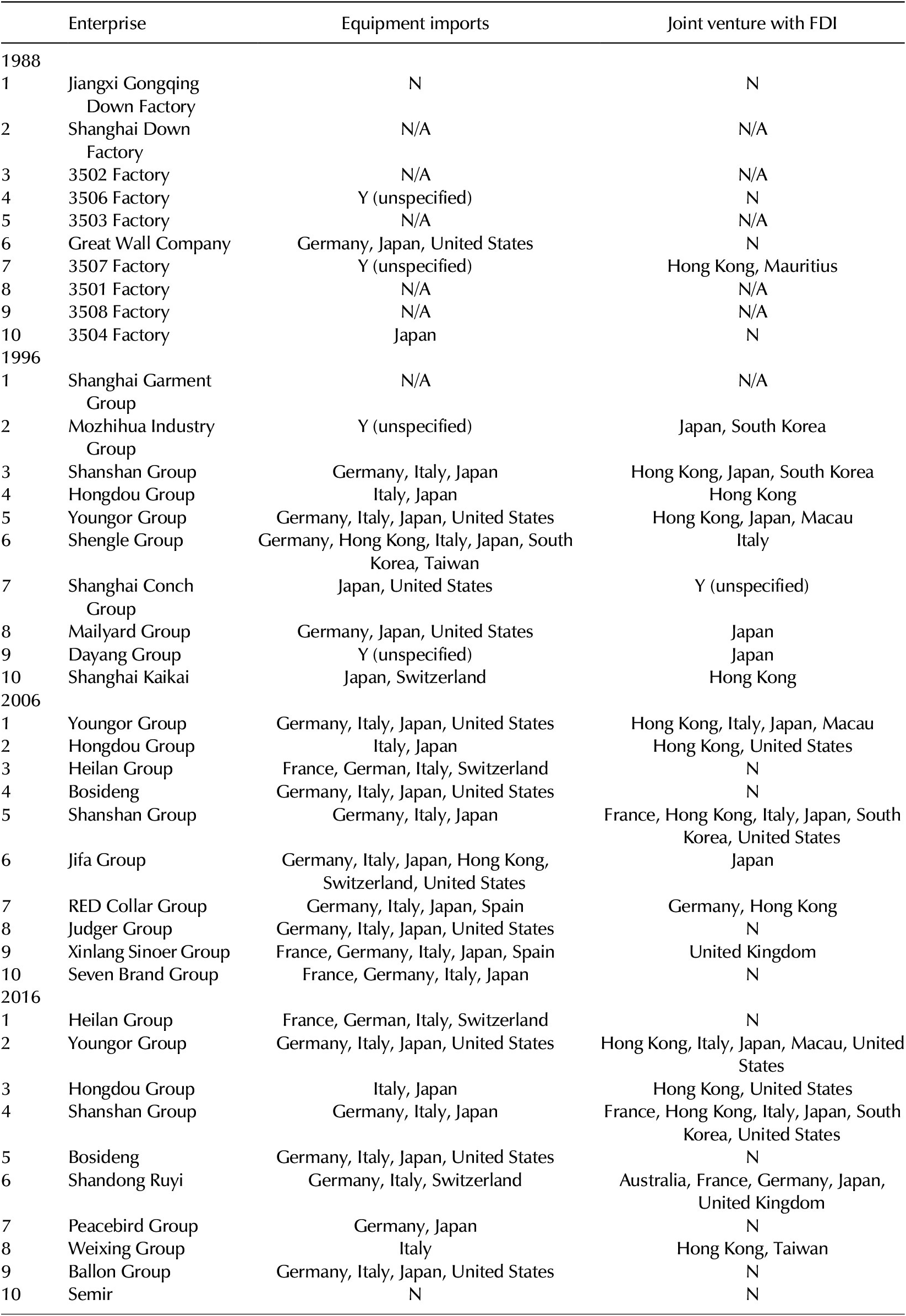
Source: Management World, no. 6 (1989); Beijing Textile, no. 3 (1997): 57–59; China National Garment Association published statistics, accessed October 14, 2021, http://www.cnga.org.cn/html/zx/hyxx/2007/0426/1685.html (2006); http://www.cnga.org.cn/html/xiehuigonggao/2017/0718/44756.html (2016). Information on technology transfer was established by the authors on the basis of yearbooks, newspapers, and magazines mentioned in the bibliography.
Note: Data before 1988 are not available. N, no; Y, yes but more explicit information not available; N/A, no data found.
In the 1990s, TVEs became the dominant force in the industry, but their situation differed from that of the SOEs. They achieved rapid technological progress from a low starting point. Mario Biggeri, Danilo Gambelli, and Christine Phillips demonstrated that cooperation with SOEs was a critical source of technology upgrading for TVEs.Footnote 51 Nonetheless, this was not a mainstream approach among Chinese TVEs. As seen in Table 2, practically all the largest companies formed Sino-foreign JVs during this period. One reason was that TVEs were usually small and lacked appropriate funding. In the early 1980s, they generally acquired equipment through cooperative operations, such as compensation trade. For example, Jifa Group introduced eighty-four sets of equipment through a knitted underwear compensation trade contract with Japanese Hyogo Trading Company in 1984.Footnote 52
Sino-foreign JVs only became a viable way of obtaining technology and capital after encouraging FDI regulations were enacted in 1986, as evident in the Youngor case. In 1990, this firm established a JV with Macau Nanguang Trading Company, which invested USD 280,000 and acquired 25 percent of the new company. Specifically, Nanguang was established in Macau by the Chinese Ministry of Foreign Trade and Economic Cooperation, which made the JV a round-trip investment in practice. The new JV purchased more than three hundred sets of manufacturing equipment from Japan, Germany, and the United States.Footnote 53 Similarly, the Japanese Matsuoka Corporation supplied capital for the establishment of Mozhihua in 1990, while the Chinese side, township Pinghu Xincang No. 1 Garment Factory, provided land, the plant, and labor, and ultimately controlled the new company. In this way, Mozhihua purchased thousands of sets of advanced equipment in four years without applying for any state funds or bank loans.Footnote 54 Moreover, Dayang Group established twenty-eight Sino-foreign JVs between 1989 and 1995, with investors from Hong Kong, Japan, South Korea, and the United States. Not only had the company raised capital and brought in automation equipment and multiple production lines, but it also expanded exports, with more than 90 percent of its products sent off to more than twenty-five countries.Footnote 55
In addition to capital and technology, some companies began to employ foreign technical experts in the early 1990s. For example, Hongdou engaged Xiao Wenfeng, a technical expert from Taiwan, as general manager of its shirt department in 1993, and Kato Atsushi, a Japanese engineer, as general manager of its suit department the following year.Footnote 56 In an industrial park constructed by Shanshan in 1998, the production lines of suits were directly managed by experts from the Japanese company Daito Textile and the Italian company Gruppo Forall, according to the companies’ cooperation agreements.Footnote 57
To sum up, the domestic apparel companies mainly obtained advanced technology by directly importing foreign equipment and establishing JVs with foreign capital. Moreover, some enterprises began to import technical experts and managerial personnel from abroad in the early 1990s. However, the technology transfer during this period did not change the position of domestic companies in the GVC, as the objective was still to expand exports as OEMs.
Searching for Added Value to Upgrade in the GVC
The knowledge needed to build a competitive advantage in the domestic market was different. Design, branding, and retail became the target of transfers, whereas apparel manufacturers focused more on production technology before 2006. The government supported this change. For example, in 2005, the Ministry of Commerce adopted a policy to support independent brand building and allocated CNY 700 million to private companies for developing their marketing and distribution channel activities in the following year.Footnote 58 However, the activities of private firms were much more important in acquiring this new type of knowledge.
Figure 5 shows the annual number of new trademark registrations by domestic apparel companies. In the early 2000s, it maintained a steady pace before accelerating abruptly in 2007. While data for the apparel industry before 2000 are unavailable, trademark data for Chinese industry across the board remained low in the 1980s and only started to grow slowly in the 1990s, until surging after 2007, suggesting the apparel industry fits the general trend.Footnote 59 Until 2019, each apparel enterprise had an average of 1.6 registered trademarks in China.Footnote 60 This demonstrates that apparel enterprises have placed a higher premium on brand building.
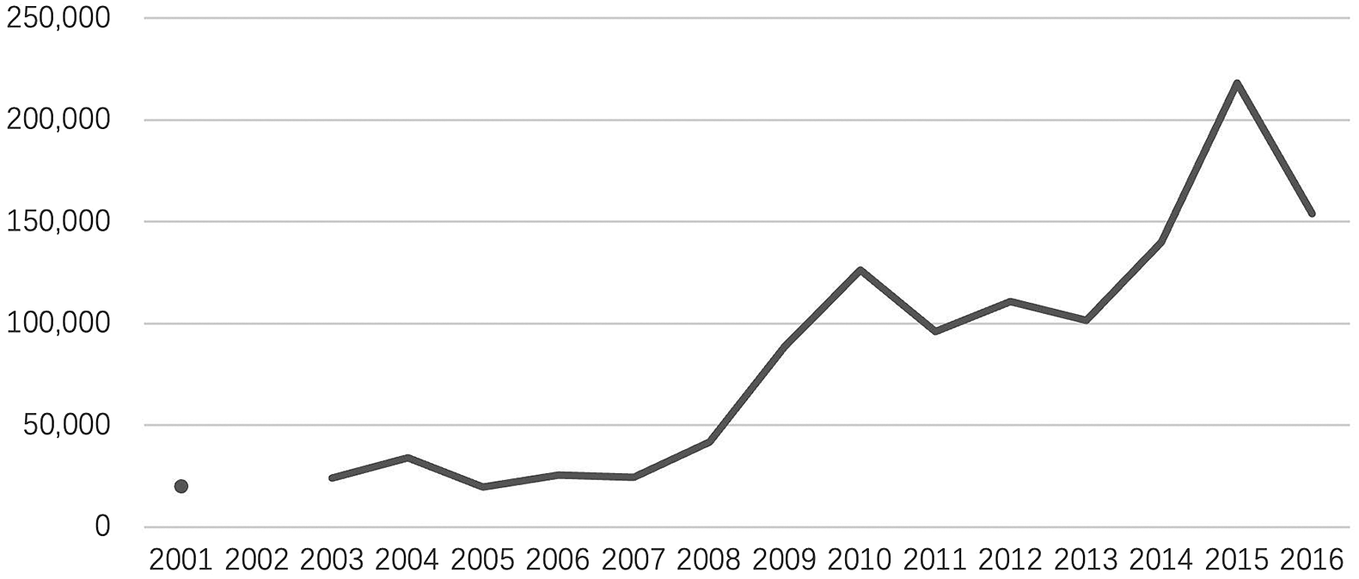
Figure 5 Annual increase of trademark registrations in the Chinese apparel industry. Trademark registration data by industry before 2000 are not available.
Source: China Intellectual Property Yearbook, 2000–2017.
Taking the companies in Table 1 as examples, most of the largest companies in 1996 were export-oriented OEMs. Although some had established independent brands in the domestic market—typically bearing the company’s name, such as Shanshan, Youngor, Hongdou, and Kaikai—OEM and export remained their core businesses. However, between 2006 and 2016, all the largest companies, with the exception of Jifa, shifted their focus to domestic sales of self-owned brands and thus upgraded to become brand retailers. In addition, most adopted a multiple-brand strategy. For instance, in 2004, Youngor’s OEM income accounted for approximately 42 percent of total revenue, while the domestic income came from its sole brand, Youngor. By 2014, OEM income had dropped to only 4 percent, and domestic sales accounted for the remainder. The company was managing five self-owned brands in the domestic market, although the pillar brand Youngor accounted for 92 percent of domestic sales.Footnote 61
As shown in Table 2, all the largest apparel enterprises founded before the mid-1990s were manufacturers and had already established a competitive advantage in apparel production in the 1990s. However, many have outsourced part or the entirety of their production to OEMs since the 2000s instead of upgrading as fully vertically integrated companies. For instance, Hongdou has remained a manufacturer while outsourcing all its jacket production to domestic OEMs since the early 2000s.Footnote 62 In contrast, Shanshan began progressively selling its factories in the early 2000s.Footnote 63 This company completely divested itself of OEM manufacturing and had outsourced all its apparel production by 2014.Footnote 64 Heilan and Peacebird followed a similar development to Shanshan.
On the other side, newcomers, like those companies in Western countries that do not own any production facilities, emerged in the late 1990s, such as Semir. This company was established in 1996 without any factories due to a lack of capital, and production was outsourced to OEMs. The company primarily focused on high value-added activities, including design, branding, and retailing.Footnote 65
In addition to upgrading endogenously, domestic apparel companies have increasingly turned to the licensing, acquisition, or joint operations of foreign brands to directly engage in high value-added activities like marketing and retailing. As early as 1999, Youngor secured a five-year licensing agreement with Pierre Cardin’s brand Maxim’s de Paris, taking charge of its production and sales in China and Southeast Asia.Footnote 66 Similarly, the company obtained a twenty-year license of the American brand Hart Schaffner Marx in 2007 and acquired its trademark right in China in 2014.Footnote 67 This portfolio has been further expanded to the Norwegian brand Helly Hansen (joint operation) and the American brand Undefeated (40 percent equity acquisition) in 2021.Footnote 68 Shandong Ruyi is a typical example of upgrading the GVC through acquisitions instead of building its own brands. Starting from 2010, it successively acquired a series of foreign fashion companies with more than forty brands, including the Japanese company Renown (with brands Arnold Palmer, Hiroko Koshino, etc.), the French company SMCP (with brands Maje, Sandro, and Claudie Pierlot), and the Hong Kong company Trinity Group (with brands CERRUTI 1881, Kent & Curwen, etc.).Footnote 69 The CEO of the company, Zhou Yafu, has expressed his ambition to build “the LVMH in China.” However, it failed due to the debt pressure caused by excessive expansion and high leverage and has now lost control of most of its acquired firms.Footnote 70 In another case, Shanshan has been operating dozens of foreign brands in the Chinese market through joint operations since the early 2000s. For instance, it established a JV with the Japanese company Itochu and the Italian company Gruppo Forall to operate the latter’s brand Marco Azzali in 2001, and another JV with Japanese firms Itochu and Descente for the latter’s brand Le Coq Sportif in 2004.Footnote 71
Knowledge Acquisition for the Domestic Market
Leading enterprises started attempting to acquire soft knowledge as early as the mid-1990s to enhance design expertise and gain marketing experience. Here, we provide detailed analyses of three companies that appeared repeatedly in the ranking, namely Hongdou, Youngor, and Shanshan.
First, Hongdou is characterized by its special attention to cultivating design competence through various collaborations since the mid-1990s. The company was founded as a knitwear manufacturer in the 1980s and stepped into producing shirts and men’s suits in the early 1990s.Footnote 72 In 1995, Hongdou chairman Zhou Yaoting became acquainted with Xiong Youwen, a female French-Chinese designer and teacher, during a visit to ESMOD, a private fashion school in Paris. One year later, he appointed Xiong the chief designer of Hongdou. Further, Hongdou and ESMOD established a joint international training center in Jiangsu Province in 1997; thus, Hongdou became the first firm in China to collaborate with foreign fashion schools. In 1999, a French professor of ESMOD serving as the chief designer, together with fifteen designers who graduated from the training center, launched Hongdou’s first casual apparel brand that catered to young people, IDF.Footnote 73 In 2009, Japanese designer Minoru Adachi, who graduated from the Japanese branch of ESMOD, was appointed the new creative director of IDF.Footnote 74
Closer partnerships have been forged progressively with more institutions and designers, both domestic and foreign, to introduce new product lines in recent years. For instance, Hongdou entered into agreements of cooperation with the Massachusetts Institute of Technology and the Beijing Institute of Fashion Technology in 2010 and 2016, respectively, covering collaborations in research, training, design, and recruitment.Footnote 75 In 2005, the company appointed domestic designer Wang Hongying as design director to launch its new women’s wear brand HOdo. Graduating from Wuhan Textile University, Wang was named one of the top ten fashion designers in China in 1999 and was one of the six designers who presented their works at the Louvre in Paris in 2003 on behalf of the China Fashion Association.Footnote 76 In 2019, Hongdou contracted with Fabio Del Bianco, the former chief designer of Moncler menswear, to develop a new collection of men’s down jackets.Footnote 77 With Patrick Grandin, the former vice president of Armani Exchange menswear, the company debuted a new line of shirts for men in 2022.Footnote 78
Youngor, our second example, has expanded into knowledge acquisition through licensing and M&As. Youngor was initially a shirt manufacturer in the 1980s. When it entered the market for men’s suits in 1994, the company imported production equipment from Italy and Germany and sent personnel to Italy to receive training in the suit-cutting process due to a lack of expertise.Footnote 79 In the aforementioned five-year licensing agreement with the brand Maxim’s de Paris in 1999, Pierre Cardin provided Youngor with design knowledge and technical support for menswear.Footnote 80 In 2007, Youngor entered into a twenty-year licensing agreement with Hart Schaffner Marx, one of the largest American suit manufacturers, for its marketing and retailing in China, with a design center in Shanghai. Hart Schaffner Marx’s designs were incorporated and localized to fit Chinese body shapes.Footnote 81 One year later, Youngor paid USD 120 million to purchase two companies, Xin Ma and Smart, from the American company Kellwood. The companies’ main business involved the design, production, and sales of menswear, with fourteen production bases in Sri Lanka, Philippines, and mainland China; ODM businesses with more than twenty global brands, such as Polo and Calvin Klein; and five licensed brands, including Nautica and Perry Ellis. Through the acquisition, Youngor absorbed design, managerial, and marketing competence, along with global distribution networks, to aid in its own brand building and advance into internationalization.Footnote 82 Youngor has recently diversified its portfolio beyond menswear. In 2021, the company partnered with Norwegian company Helly Hansen through a JV to promote its outdoor brand in China, with a localized design center to respond to the Chinese market.Footnote 83 Recently, Youngor has further acquired 40 percent of American streetwear brand Undefeated and made a minority investment in American fashion brand Alexander Wang.Footnote 84
Besides that, similar actions as those used in Hongdou were applied in Youngor. In 2000, the company and Zhejiang Business Technology Institute collaborated to establish a training facility to cultivate marketing personnel. The two-year session included a wide range of courses, covering marketing, accounting, and clothing design.Footnote 85 Foreign marketing professionals and designers were employed to bridge the gap in expertise. In 2001, the company signed Aubry Marty as its marketing consultant on a three-year contract. Marty was a French creative consultant who had previously worked for several luxury brands, including Chloé and Dior. He designed new mono-brand stores to enhance the brand identity of the menswear brand Youngor, which was linked to masculinity and environmental protection.Footnote 86 This was one of the earliest marketing attempts by Chinese apparel companies in terms of store design. In another, Youngor cooperated with Japanese designers to launch its new menswear brand GY in 2009, targeting the younger market.Footnote 87
Shanshan, the third company we examine in depth, focuses on joint operations with foreign companies through Sino-foreign JVs. The company had achieved dominance in the 1980s as a men’s suit manufacturer and once reached a market share of 37 percent in the 1990s.Footnote 88 Beginning in the late 1990s, Shanshan started to actively implement a multi-brand strategy and pursue collaboration with foreign companies through JVs in the Chinese market while changing the business model of its own brands from direct-owned stores to franchised outlets and outsourcing its production to domestic OEMs. To get in touch with foreign companies, Shanshan chose to cooperate with the Japanese trading company Itochu, which licensed more than 150 international brands. Itochu held a stake in these JVs, and Shanshan obtained managerial expertise from Itochu in return.Footnote 89 Specifically, Shanshan, Itochu, and the brand owner jointly established a JV, with Shanshan taking a controlling stake and Itochu taking a minority stake. Further, in 2009, Itochu acquired 28 percent of Shanshan and dispatched four executives to work directly on the company’s operations.Footnote 90
Between 2000 and 2010, Shanshan introduced numerous foreign brands through this tripartite cooperation, including Marco Azzali, Le Coq Sportif, Callaway, Pinky & Dianne, Renoma, Lubiam, IORI, and Smalto.Footnote 91 In the operation of the brand Le Coq Sportif undertaken with Descente and Itochu, the Japanese chief designers visited China twice a year to guide the design works, and bilaterally, the Chinese designers traveled to Japan twice a year to participate in training and design. Products for the Chinese market were selected from existing goods in Japan and then tailored to local tastes by Japanese and Chinese designers. In 2006, 20 percent of the products sold in the Chinese market were completed independently by Chinese designers.Footnote 92 “Our objective is not to undertake OEM for international brands, but to incorporate and nurture managerial and design competency through operating these international brands,” claimed Zheng Yonggang, the CEO of Shanshan.Footnote 93
The company’s multi-brand strategy also targeted domestic designer brands in addition to foreign brands. For example, in 2002, Shanshan took a controlling stake in the brand Firs & Designer, which was founded by three French designers (one of whom was French-Chinese), and the brand Rosew, which was founded by Chinese designer Liu Wei.Footnote 94 Shanshan employed top designers to promote their own brands as well. In 1996, Shanshan signed two of China’s most renowned designers at the time, Wang Xinyuan and Zhang Zhaoda, as chief designers to launch the women’s wear brand Lefancy. The company opened a studio in France for them as a source of design inspiration.Footnote 95 However, due to continued profit losses of the multi-brand business, the company sold most of its stakes in JVs and self-owned brands as of 2016, retaining operation of only four brands.Footnote 96
In addition to the companies analyzed here, Table 3 shows that collaborating with foreign brands through licensing, acquisition, or joint operation provided domestic apparel companies with a direct route to acquire soft knowledge and move up the GVC in the domestic-oriented period. Employing professionals and cooperating with institutions, both domestic and foreign, enabled the companies to enhance their own competency in design, marketing, and management, hence pursuing high added value in the GVC. It is worth noting that some companies do not need to adopt these strategies. For example, Jifa Group remains an OEM manufacturer without its own brand; Weixing Group is a garment accessory supplier; and Ballon Group mainly manufactures uniforms for the government and SOEs, occupying a relatively stable niche market (see Table 3).
Table 3 Knowledge acquisition data for the ten largest apparel companies in 2006 and 2016
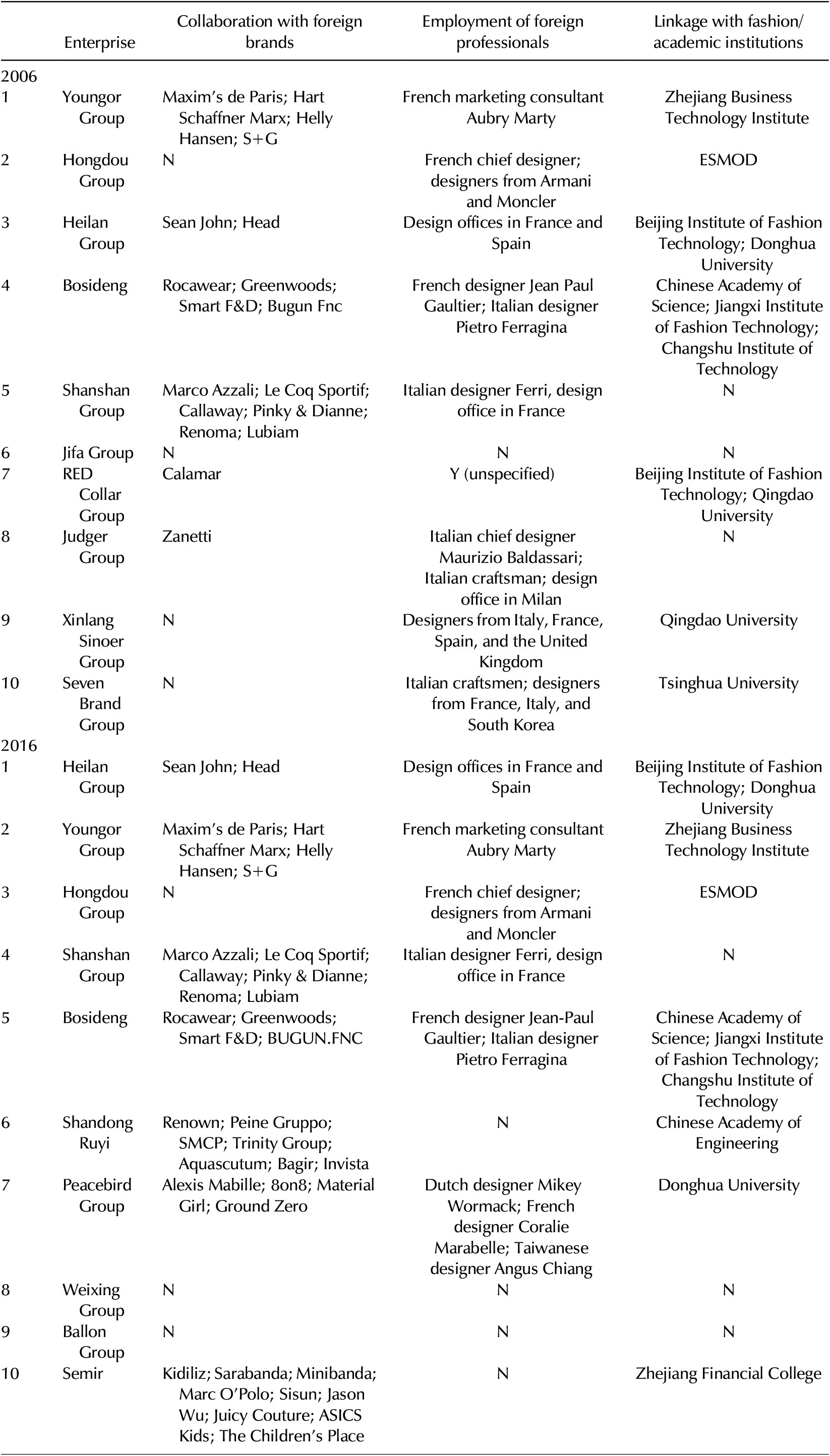
Source: Management World, no. 6 (1989); Beijing Textile, no. 3 (1997): 57–59; China National Garment Association published statistics, accessed October 14, 2021, http://www.cnga.org.cn/html/zx/hyxx/2007/0426/1685.html (2006); http://www.cnga.org.cn/html/xiehuigonggao/2017/0718/44756.html (2016). Information of knowledge acquisition was established by the authors on the basis of yearbooks, newspapers, and magazines listed in the bibliography.
Note: Data before 1988 are not available. N, no; Y, yes but more explicit information not available.
Conclusion
After the reform and opening up to trade in 1978, the Chinese apparel industry grew from a weak base to being today’s largest supplier of clothing exports in the world. It developed in two distinct phases: the export-oriented period from the 1980s to the mid-2000s, and the domestic-oriented period after 2005. Specifically, most of the major players in the domestic market resulted from the privatization of the former leading export-oriented firms and their changing strategies, while some newcomers also demonstrated vigorous growth.
The knowledge acquired during the two periods took different forms to answer specific needs. Companies in the export-oriented period were mainly OEMs that needed to upgrade technology. Direct equipment imports and establishing Sino-foreign JVs were two popular methods to obtain technology. However, the technology acquisition during this period was meant to bridge the technological gap between the leading foreign exporters at the time and the Chinese manufacturing companies to gain an advantage in global apparel exports. Consequently, it had no effect on these companies’ position in the GVC. They remained mostly outsourcers.
However, during the domestic-oriented period, knowledge related to branding, design, and marketing became the new emphasis in the face of fierce competition from foreign brands in the domestic market. The largest companies basically obtained this expertise through collaboration with foreign brands, employment of foreign professionals, and linkages with fashion and academic institutions. The knowledge transfer during this period facilitated the Chinese apparel companies’ transition from OEM manufacturers to independent brand retailers that focused on the sales of branded products, thus ultimately helping to gain added value and upgrade their position in the GVC.
Beyond the specific case of the apparel industry, this paper contributes to demonstrating the way Chinese firms were able to acquire soft knowledge to improve their position in the GVC, as most of the research on the growing competitiveness of Chinese firms has focused on companies in the high-tech industries, like automobiles or information technology, where technology is the key issue for growth.Footnote 97 However, a remaining issue for analysis is whether the soft knowledge that enabled Chinese firms to gain competitiveness in their domestic market was used to foster their international expansion.












